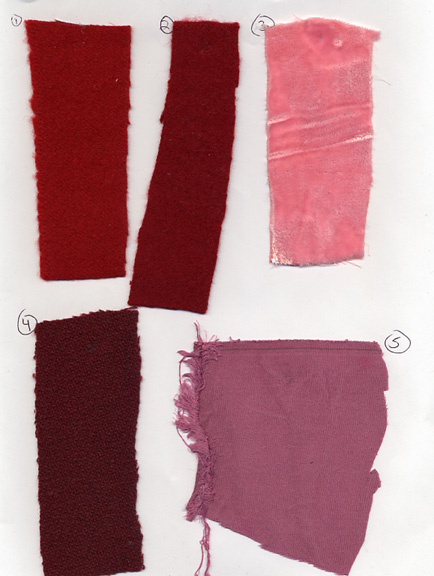1.Mordant, dyebath, afterbath.
2.Mordant, dyebath, 2nd (saddening) afterbath
3.Velvet: mordant, dyebath, afterbath
4.No Mordant, exhaust dyebath.

Second try.
Ingredients:
1 lb cloth
4 oz grain
1/2 oz alum + 1 oz tartaric acid (mordant)
.4 oz alum + .4 oz tartaric acid (afterbaths)
Fermented Bran Water
Process:
Put alum & tartaric acid in 3 gallons of water. Bring to a boil, and enter goods. Simmer for 1.5 hours. Rinse.
Combine 4 gallons of water, 1/2 a gallon of bran water, 4 oz. powdered cochineal. Bring to a boil. Enter wool. Boil for 1 hour, stirring constantly. Rinse.
Combine .4 oz alum & .4 oz tartaric acid & 4 cups of bran water & 3 gallons of water. Bring to the boil. Enter the goods, and simmer 15 minutes. Rinse.
Notes:
Due mostly to scaling back the alum in the mordant and replacing cream of tartar with tartaric acid (weaker) in the mordant and afterbath, this came out much more scarlet than the last batch. The color looks truer to the reds in Venetian paintings of clothing. The silk velvet, silk skeins & linen thread I had in the batch were a disaster, though! Despite mordanting, the velvet came out pale pink and the silk thread came out lilac. Must find out what went wrong. Because I hoped to use this fabric to finish the jacket made with the first recipe, I tried another saddening afterbath with 1 oz lime to try and sadden the red to match the original. It turned out OK...not perfect, but close. The alum/tartar afterbath had even more of a brightening effect this time around than last time. I only did one, as I didn't have time to bring the pot to the boil three times in a row that night. The bran water had a pH of 5.5. Adding bran water to the dyebath had no noticeable effect on the dyebath color.
Next time: Test mordanting with cream of tartar vs. tartaric acid. Dye without bran water and compare with existing bath. Use 6 oz cochineal instead of four (four was all I had). Set things up so that the exhaust bath can be used as a preliminary dye for Dutch Scarlet as described in the Whole Art of Dying. Test to see if two dye baths of 1 oz cochineal/lb of wool can produce the same effect when each boiled for an hour, as described in 17th & 18th c. sources, to save money.
Samples:
1.Mordant, dyebath, afterbath.
2.Mordant, dyebath, 2nd (saddening) afterbath
3.Velvet: mordant, dyebath, afterbath
4.No Mordant, exhaust dyebath.
